May 21, 2025 | 03:09 GMT +7
May 21, 2025 | 03:09 GMT +7
Hotline: 0913.378.918
May 21, 2025 | 03:09 GMT +7
Hotline: 0913.378.918
In the Mekong Delta, Tien Giang stands out with its numerous large-scale rice processing and exporting businesses, contributing significantly to bringing Vietnamese rice to global markets. However, market researchers indicate that local rice production and business operations are facing considerable challenges and need support from multiple sectors. This issue was raised at a scientific workshop on enhancing processing and export capacity of Tien Giang’s rice, organized by Tien Giang Provincial People's Committee on October 29, 2024.
Thanks to favorable natural conditions, Tien Giang has become one of the nation’s rice-producing regions, with over 56,000 hectares of paddy land. In 2023, total cultivation for three crops spanned 129,000 hectares, accounting for 3.4% of the Mekong Delta’s rice-growing area and 1.8% nationwide, yielding nearly 790,000 tons of rice (3.1% of the delta’s rice output and 1.9% of national output).
Currently, Tien Giang has two concentrated rice production zones. The high-quality rice production zone, located in the western districts such as Cai Be, Cai Lay, Tan Phuoc, and Cai Lay town, spans 21,000 hectares and yields 428,000 tons annually. Meanwhile, the aromatic rice zone is in the eastern districts of Go Cong Tay, Go Cong Dong, and Go Cong city, covering 18,000 hectares and producing about 314,000 tons per year.
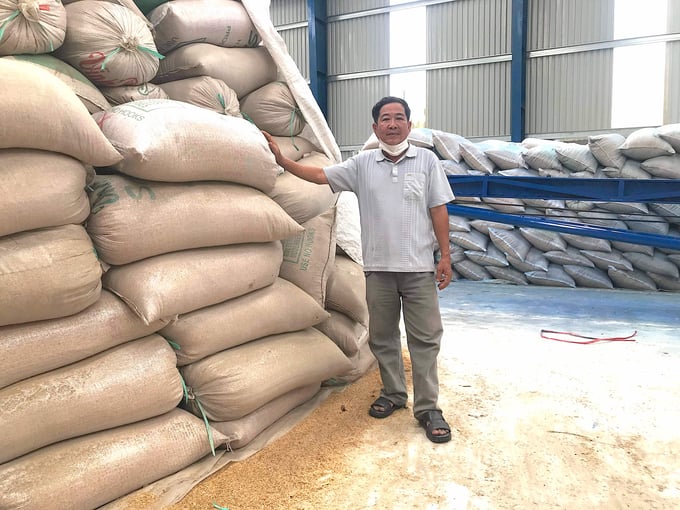
Tien Giang has around 500 businesses processing and exporting rice.
Although the provincial rice-growing area is modest, Tien Giang has a large-scale rice milling and trading infrastructure within the delta. According to the Department of Industry and Trade, Tien Giang has around 500 businesses specializing in milling, processing, consumption, and exporting rice, mainly in the agricultural production regions of the western districts.
With an annual milling output of over 2 million tons of rice, Tien Giang is a major rice consumer and supplier for both domestic and export markets within the Mekong Delta. Cai Be district hosts over 160 processing facilities, accounting for more than 30% of the province’s total rice processing facilities, with 80% concentrated in the Ba Dac area and the An Thanh Industrial Cluster. This area also attracts traders from various provinces to buy and sell rice. Mr. Phan Thanh Son, Vice Chairman of the People’s Committee of Cai Be district, shared.
“The rice-growing area in our district is currently around 6,000 hectares, producing about 150,000 tons for processing and export. However, with a high concentration of processing plants, especially in the An Thanh industrial cluster, local production does not meet the demand, requiring imports from neighboring provinces such as An Giang, Dong Thap, and Long An.”
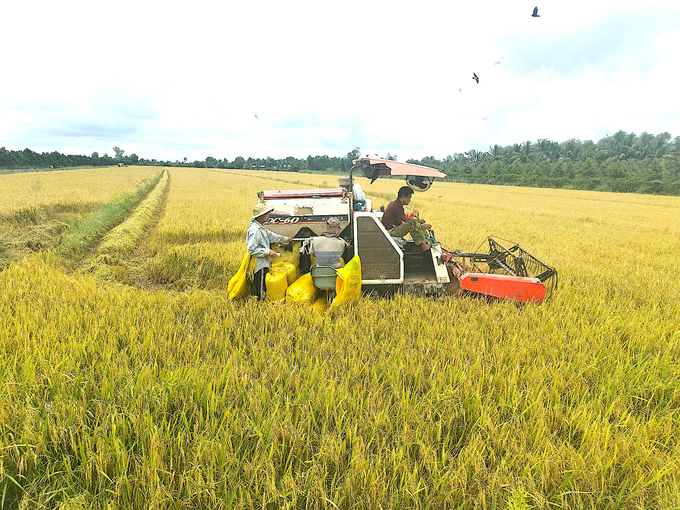
Harvesting rice in Tien Giang province.
Tien Giang now hosts 20 rice processing and exporting companies, such as Tien Giang Food Company, Viet Hung Company, and Dat Duc Thinh Company, which have invested in automated systems from drying, sorting, polishing, color sorting, grain selection, to packaging, enhancing the quality of rice products for the market. About 480 other companies still rely on traditional methods with limited efficiency and lack of color-sorting technology. Commenting on this, Mr. Ngo Thanh Van, Director of Tien Giang Food Company, said:
“Tien Giang is the fourth-largest rice-exporting province in the country. However, local businesses have yet to invest in drying, polishing, and color-sorting technology, which impacts competitiveness and product value. Our rice market mainly exports to China, the largest global consumer of rice and food. Yet, in recent years, we have faced fierce competition from businesses in Thailand and Cambodia.”
Recently, the export volume of rice from Tien Giang, as well as the nation, has shown a downward trend. The Tien Giang Department of Industry and Trade reported, “From 2018-2022, the province exported around 993,000 tons of rice, with revenue reaching approximately USD 521 million. In 2023, rice exports exceeded 175,000 tons, valued at USD 105 million. In the first six months of 2024, exports reached over 81,000 tons, valued at USD 52 million, down more than 24% in volume and over 18% in value year-over-year.”
The decline in rice exports is attributed to various factors, primarily the higher price of Vietnamese rice compared to some other countries. Additionally, the rice production, processing, and export sector faces issues such as weak linkages between rice-producing farmers and businesses, limited rice processing capabilities, inconsistent rice quality, high production costs for farmers, and inflexible bank credit policies that fail to support businesses when needed. Some rice processing factories also struggle with facility limitations, land issues, and environmental pollution due to dust emissions.
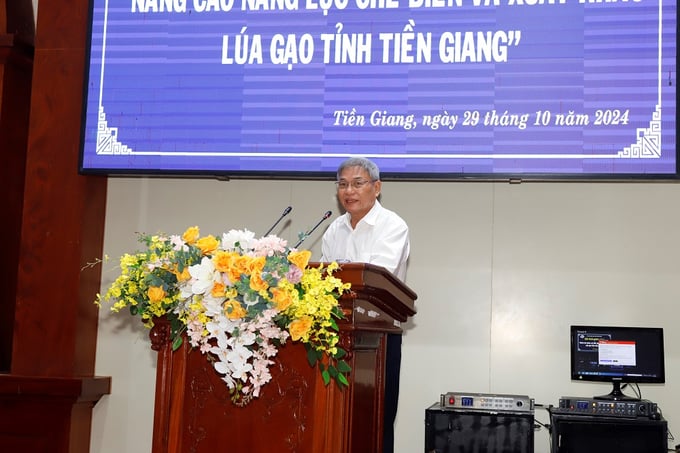
Dr. Nguyen Van Sanh, former Director of the Mekong Delta Development Research Institute (Can Tho University).
Dr. Nguyen Van Sanh noted that companies engaged in rice export must also value the domestic market. He mentioned that today’s rice consumers prioritize quality over quantity. Meanwhile, Vietnam’s rice export sector, including Tien Giang, is under intense competition from Thailand, India, Myanmar, and Cambodia. He believed that investments should focus on improving rice quality at every stage, from seed selection to production and processing.
“The essential investment is in raw materials and upgrading the supply chain according to market segments. Priority should be given to developing material zones and establishing large-scale fields, selecting rice varieties based on market segments and climate adaptability, and producing in a clean, green direction," Dr. Sanh emphasized.

Ms. Dao Thi Thanh Xuan from the Import and Export Department of Ministry of Industry and Trade.
Ms. Dao Thi Thanh Xuan pointed out that Vietnam is one of the world's top three rice exporters. Vietnamese rice is exported to the Philippines, Indonesia, China, Côte d'Ivoire, and Ghana (Africa). However, Vietnamese rice exports are facing both opportunities and challenges.
She noted limitations in rice export, such as quality, flavor dependency on weather, limited production linkage, underdeveloped processing infrastructure, and competition with rice-exporting countries like Thailand. The lack of market diversification and weak Vietnamese rice branding also reduce visibility. Furthermore, political factors and price fluctuations impact Vietnam’s rice market.
However, Ms. Xuan believed that there is an opportunity to improve rice quality by emphasizing green agriculture as a foundation and leveraging food security as a pillar to advance agriculture towards organic and circular models.
Rice from Tien Giang province has been exported to 20 markets around the world. In the first six months of 2024, the Philippines was the largest rice importer from the province, accounting for 31%, followed by China with 29%, Singapore with 19%, Africa with 11%, and Hong Kong with 6%... in total rice export value. Additionally, Tien Giang's rice has also been exported to several other markets including South Korea, Kuwait, and New Zealand.
Translated by Kieu Chi
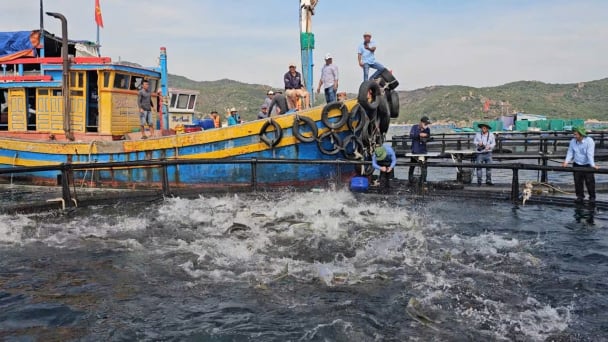
(VAN) Khanh Hoa is investing over 545 billion VND to develop 240 hectares of high-tech marine aquaculture in order to guarantee a consistent supply of seafood exports and achieve the USD 1 billion target.
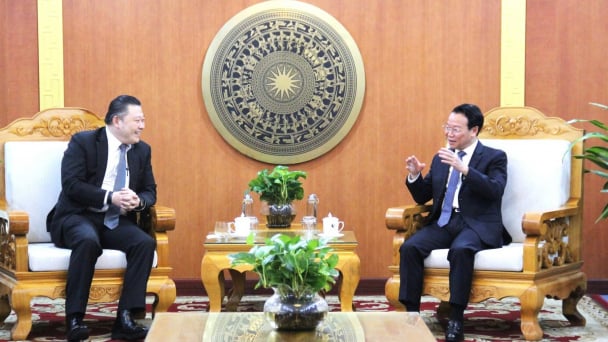
(VAN) Minister of Agriculture and Environment Do Duc Duy held a meeting with Soopakij Chearavanont, Chairman of C.P. Group, on May 15.
/2025/05/16/3800-0-nongnghiep-143756.jpg)
(VAN) Suntory PepsiCo Vietnam coordinated with the Ministry of Education and Training to implement an education program on water conservation, reaching nearly 1 million primary school students nationwide.

(VAN) Vietnam’s TH Group officially put its high-tech fresh milk processing plant into operation in the Russian Federation, marking a historic moment as the first TH true MILK cartons were produced in Russia.

(VAN) Use of high-quality broodstock and biotechnology is regarded as the most effective approach to ensuring sustainable and economically viable shrimp aquaculture ahead of climate change and the emergence of increasingly intricate disease patterns.

(VAN) Carbon farming is a form of agricultural practices that helps absorb more greenhouse gases than it emits, through smart management of soil, crops, and livestock.

(VAN) This is a key content of the Memorandum of Understanding recently signed between the Vietnam Fisheries Society and Kunihiro Inc of Japan.